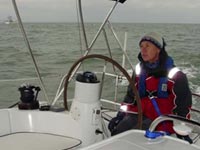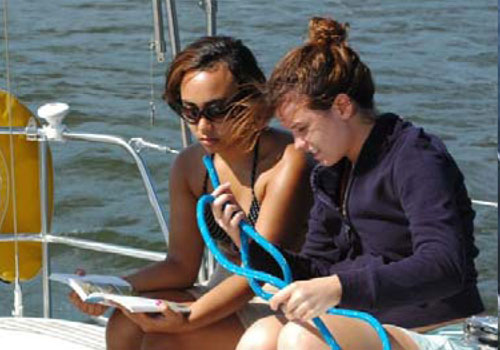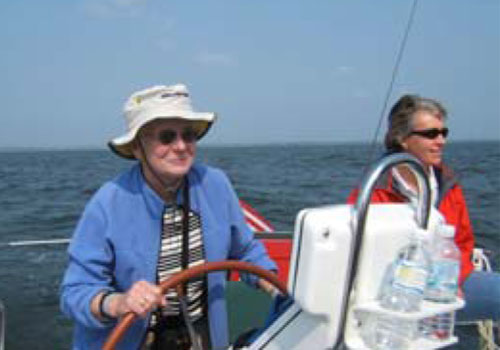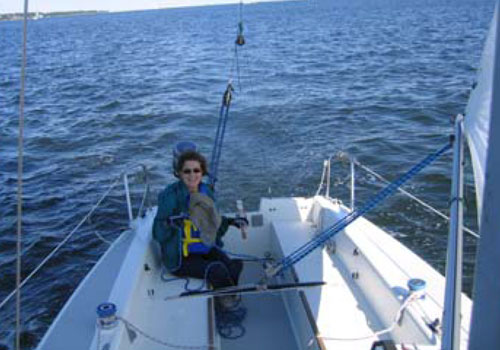By Capt Lisa Batchelor Frailey
Women really do learn sailing differently from men. As a retired Naval Officer, US Coast Guard Captain, Sailing Instructor and co-owner of a Sail Solomons Sailing School, it took a season or two of instructing in the “real world” for me to truly recognize and acknowledge the difference. But embracing the concept of learning styles has enabled our Sail Solomons instructors to teach better across the genders.
Background
I am a retired US Naval Officer, having spent 24 years on Active Duty as a Naval Flight Officer and Oceanographer. I attended flight school in 1982, the 3rd year that the Naval Flight Officer designation was open to women. There, as in many competitive work environments, there can be no gender-specific training; to do so would alienate female students from their male colleagues. There simply aren’t the resources to accommodate different learning styles, much less genders. So while we women officers formed close, unofficial support groups, we trained and worked the same way as our male counterparts, and tried to ignore (or deny) the differences. However, teaching sailing in the real world, I see things differently. Most women students that I’ve encountered have very different motivations and learning styles than men. While I already knew of basic learning styles, I hadn’t realized how gender-aligned these styles seem to be. Whether teaching a single or mixed gender course, its important that instructors recognize the differences in students’ learning styles, and balance instructional techniques to provide the most effective and enjoyable training for all.
Sailing Partners
 My husband Andy and I learned to sail long before we met each other. Andy learned though the Royal Yachting Association, and I learned through a combination of seat-of-the-pants, friends, and Navy sailing courses. Andy and I met at a sailing regatta, owned boats independently, and have made many of our life decisions (both personal and business) while on the water – far from the demands of shore-bound life. So when we bought our first “together” boat we were surprised at the conflicts that arose. Each of us was used to being Captain, and we each had our own ideas on “the right way” to do things on a boat. We adopted a few practices which have really helped:
My husband Andy and I learned to sail long before we met each other. Andy learned though the Royal Yachting Association, and I learned through a combination of seat-of-the-pants, friends, and Navy sailing courses. Andy and I met at a sailing regatta, owned boats independently, and have made many of our life decisions (both personal and business) while on the water – far from the demands of shore-bound life. So when we bought our first “together” boat we were surprised at the conflicts that arose. Each of us was used to being Captain, and we each had our own ideas on “the right way” to do things on a boat. We adopted a few practices which have really helped:
- Alternating Captains – when we’re cruising on our own, we alternate days when each of us is Captain. The Captain has the helm, makes the calls on sails, and takes overall responsibility for the boat and crew (standard Captain duties). The other covers navigation, line and sheet handling, meals, external communications. The practice of alternating Captain and Crew positions ensures we both stay proficient at all the skills required onboard. Equally important – it makes us refine our leadership styles (planning, constructive communication, feedback, timing, etc) and fosters teamwork. By learning to become good Crew, we each become better Captains, as well.
- We have a standing arrangement that when we disagree on the risk involved in an event or maneuver, then the more conservative choice wins. There is certainly plenty of discussion involved, but the advance agreement keeps discussion from escalating to argument; the result is generally a compromise. If either of us is operating too far out of our comfort zones, then nobody is happy. We learned this practice from Bernadette and Doug Bernon of Ithaka, having heard them speak at a Safety at Sea seminar in Annapolis.
- Practice, practice, practice. Take time to learn your partner/crew’s styles, comfort zones, strengths and weaknesses. Communicate with your sailing partner, never assume he/she just “knows” the plan. If things go wrong, then talk it over later, with the intent to learn and improve.
- We sail with other captains and crews, sail with instructors, and continue our maritime education. Sailing is a life-long learning journey, with many facets to the education.
No matter how you learned to sail, you need to practice and re-train with your sailing partner. If sailing with your spouse or partner is stressful, then “Sailing in Harmony” lessons may help save your relationship!
Basic Instincts
 In general, I’ve found that our women students are more cautious than the men – probably basic survival and protective instincts. Women will point out marine traffic well before that traffic becomes an issue; they’ll be faster to reef the sails, and they generally have more questions on safety than their male counterparts. As students train and practice, they gain confidence and control, and realize that they’re perfectly capable of handling situations which seemed scary at the start. The survival instinct keeps a sailor alert and attentive, but training allows the sailor to discriminate between “normal event” and “danger”, and to handle the event accordingly. Many courses for women seem to focus on the fear factor – the message seems to be that women should take courses so they can survive if their husband is incapacitated (eg. Suddenly Solo, Sail Yourself Safely Home). Absolutely good skills to learn, but I find it more effective to focus on the positive – learn for enjoyment and achievement of sailing – solo or as a team.
In general, I’ve found that our women students are more cautious than the men – probably basic survival and protective instincts. Women will point out marine traffic well before that traffic becomes an issue; they’ll be faster to reef the sails, and they generally have more questions on safety than their male counterparts. As students train and practice, they gain confidence and control, and realize that they’re perfectly capable of handling situations which seemed scary at the start. The survival instinct keeps a sailor alert and attentive, but training allows the sailor to discriminate between “normal event” and “danger”, and to handle the event accordingly. Many courses for women seem to focus on the fear factor – the message seems to be that women should take courses so they can survive if their husband is incapacitated (eg. Suddenly Solo, Sail Yourself Safely Home). Absolutely good skills to learn, but I find it more effective to focus on the positive – learn for enjoyment and achievement of sailing – solo or as a team.
Learn on small boats
We find that basic sailing is best learned on small boats, where cause and effect is apparent. Students can really feel the boat, and get a good understanding of sail trim, weight and balance. At Sail Solomons, we use the Capri 22 (tiller steered keelboat) for beginning sailing courses. (They’re also really fun boats!) Students then progress to larger cruising boats, and bring their skills to the next level.
Spouses aren’t always the best teachers
Most of us have figured this out – from driving, cooking, laundry or sailing. I had a call last year from a gentleman who asked “Do you have a course for wives of guys who race?” (Translation: “I’m in race mode, and I don’t have the time, teaching skills or patience to teach my wife”) I designed a course for this gentleman’s wife, sister-in-law and mother, shown here – based on what THEY wanted to gain. In fact, Danielle, Patty and Jean knew a lot more than they were aware of, absorbed just from being onboard with their spouses; they just didn’t know the terminology (“that foreign language my husband yells to me”), nor did they have the confidence to practice or demonstrate their skills. After 3 days of training in a supportive, paced-to-order environment, all three were happy sailors. Patty’s remarks are included below:

“My Mother-In-Law, Sister-In-Law and I have recently finished a 2-day sailing lesson, as well as a private lesson on a motorboat with Sail Solomons. We all had varying degrees of experience, and were very eager to gain a greater understanding of sailing concepts and verbiage. We worked mostly with Lisa, and I must say, she was more than fabulous! Her patience, understanding and ability to extract exactly what each of us wanted to get from our lessons ended up being exactly what we all needed! Lisa’s confidence in our boat handling skills and sailing gave us all the support and push we needed to excel in these lessons. Sailing is supposed to be fun! Prior to taking these lessons, it wasn’t always that way. I am now much more comfortable docking a boat, and have a much greater knowledge base of sailing verbiage, which is essential in communicating with the captain and crew, and I cannot wait to get back out on the water and have some sailing fun!”
Examples, and More Examples

“The Belles” of Philadelphia regularly cruise together on charter boats. There is a variety of experience level onboard, with a core team of Captain and Mates. Nonetheless, everyone participates in crew orientations, engineering checks, docking and sailing maneuvers. Nobody is bored, and everyone learns. Prior to their first catamaran cruise, the Captain had asked for a multi-hull text, which she studied in full. Upon arrival, I took them out for an hour of multi-hull, close-quarters maneuvering practice, which allowed her and the crew to transition from text concepts to hands-on learning.

Diane chartered for a week, but hired a captain for the first 2 days to teach her, her husband and their 3 girls to sail together safely and in harmony. Here, college freshman Claudia and Kate practice knot-tying with the help of an illustrated book.

Julie owns and sails her own S2 on Lake Champlain, VT. She continues to develop her skills on larger boats, cruising and racing. Here, Julie takes advantage of low-wind motoring conditions to brush up on navigation and piloting. In a supportive training environment, Julie can ask all the questions she wants to help her understand key concepts.

Brenda, 76 years young, takes her first sailing lesson with her daughter Karen (not shown). Age was no consequence, Brenda simply wanted to experience sailing, but also have her support structure nearby.

Kathy and her husband Dave took sailing lessons together, in a group of 4 students. But it was when they went out on their own that the learning really took hold. Experiencing a greater range of conditions, and relying on their own judgment and decision-making, both Kathy and Dave feel confident in progressing to the next level.
